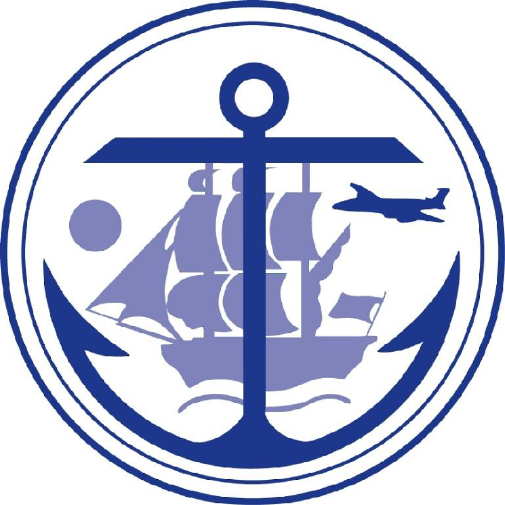
Municipality of Anchorage
SAP Project
Program Charter
V17.4
April 14, 2016

SAP Project
Program Charter
Page 2 of 20 04/14/2016
TABLE OF CONTENTS
1 Summary of Changes ............................................................................................................................. 3
2 SAP Project ............................................................................................................................................. 3
2.1 SAP PROJECT BACKGROUND .......................................................................................................... 3
2.2 SAP Project Scope and Benefits ..................................................................................................... 4
2.3 SAP Project Implementation Approach ......................................................................................... 4
2.4 SAP Project Principles .................................................................................................................... 6
2.5 Decision-Making Matrix ................................................................................................................. 6
3 SAP Project Governance ......................................................................................................................... 7
4 SAP Project Governance Roles ............................................................................................................... 7
4.1 Executive Sponsor .......................................................................................................................... 8
4.2 Executive Steering Committee ....................................................................................................... 9
4.3 Change Control Board .................................................................................................................... 9
4.4 Program Sponsor .......................................................................................................................... 10
4.5 MOA Program Manager ............................................................................................................... 11
4.6 Program Management Office ...................................................................................................... 12
5 Performing Entities .............................................................................................................................. 13
5.1 Functional Teams ......................................................................................................................... 13
5.2 Technical and Integration Teams ................................................................................................. 14
5.3 Organizational Change Management and Training Teams .......................................................... 15
6 Advisory Bodies .................................................................................................................................... 15
6.1 Functional Steering Committee ................................................................................................... 15
7 Authority and Control .......................................................................................................................... 17
7.1 Program Approval and Funding ................................................................................................... 17
7.2 Program Decision-making and Program Changes ........................................................................ 17
8 Contract Management and Administration ......................................................................................... 18
9 Program Resource Management ......................................................................................................... 19
10 Program Budget ............................................................................................................................... 19
11 Charter and Governance Maintenance ............................................................................................ 19
12 Charter Approval .............................................................................................................................. 20
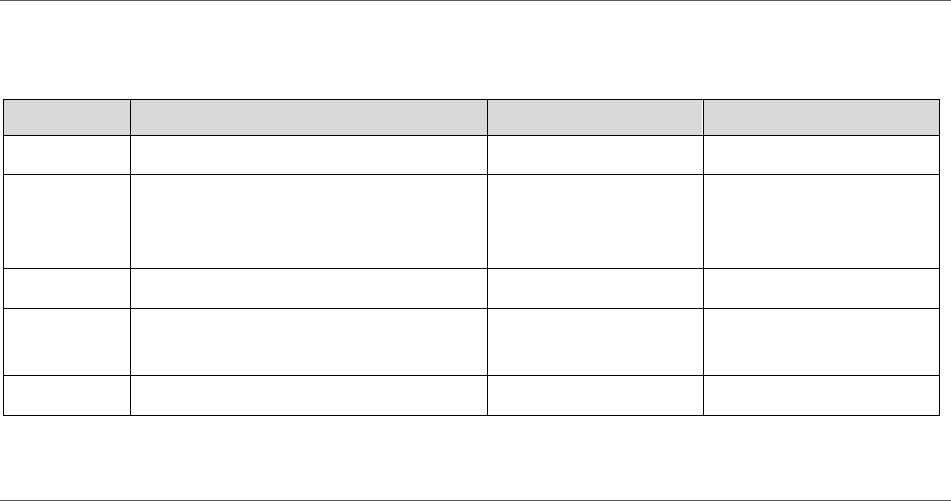
SAP Project
Program Charter
Page 3 of 20 04/14/2016
1 SUMMARY OF CHANGES
The following table summarizes the changes in content from the document’s previous published
revision.
Revision
Description
Author
Release Date
17.0
Initial revisions for discussion
Chris Fellows
November 9, 2015
17.1
Minor content and formatting
updates. This version to Program
Sponsor for review.
Chris Fellows
November 17, 2015
17.2
MOA edits to entire document
John Marcinko
March 28, 2016
17.3
SAP and MOA final edits
Matt Johnsen, John
Marcinko
April 8, 2016
17.4
MOA Edits
John Marcinko
April 14. 2016
2 SAP PROJECT
The Municipality of Anchorage (MOA) is conducting the SAP Project, which will provide business and
IT operational benefits by reducing the Municipality’s enterprise risk. The broad scope of the program
includes replacing the Municipality’s existing legacy enterprise systems and manual processes with
SAP. The SAP software will provide for more efficient and effective transaction processing and
reporting, together with reduced risk and cost of IT operations.
2.1 SAP PROJECT BACKGROUND
MOA’s financial and human resource processes are currently supported by a version of PeopleSoft
that was implemented the Municipality in 1998. This version of PeopleSoft lacked native public sector
functionality, such as purchasing, grants, and budgeting, required by the Municipality. The original
PeopleSoft implementation project budget of $9.5 million grew to $30 million, partly because of the
need to enhance significantly the PeopleSoft software to meet MOA requirements.
After going live, the PeopleSoft system had many technical flaws and low user acceptance. Even
following an immediate upgrade, the system did not meet MOA’s business needs. In 2003, PeopleSoft
ended annual maintenance for this version of their product, and MOA lost the ability upgrade their
PeopleSoft solution.
In 2006, the Gartner Group found during a review of the MOA’s PeopleSoft implementation that:
The impact of 16 years of accumulated data volume, together with lack of a data-archiving feature,
was resulting in deteriorating system performance.
Limited ability to control system security access represented a significant risk.
SAP Project
Program Charter
Page 4 of 20 04/14/2016
Severe system resource usage and performance degradation had resulted in cessation of audit
tracking, representing a further risk.
The PeopleSoft modules for Procurement, Grants and Budgets did not meet MOA’s business
needs.
In addition to functional issues with the PeopleSoft system, the infrastructure on which the system
operates on is now obsolete. This infrastructure is therefore expensive and difficult to maintain and
expand, and at risk of irrecoverable failure. Due to the obsolescence of the system software,
infrastructure and operating system, there is no feasible method of recovery to operations following
a major failure of the PeopleSoft solution.
Because of lack of functionality and issues with the PeopleSoft system, MOA’s core financial and
human resource business management activities remain heavily reliant on Microsoft Excel and Access-
based systems for transaction processing and reporting. For example, multiple manual re-entry of
transactions is normal for movement of data between systems.
2.2 SAP PROJECT SCOPE AND BENEFITS
To overcome the issues identified with the PeopleSoft system and the related business processes, the
Municipality initiated the SAP Project in 2011. Currently, the SAP project has completed the blueprint
phase, and is beginning the realization phase.
The SAP Project will replace the PeopleSoft system and Excel-/Access-based manual processing that
is relied on for current day-to-day operations with SAP-based business transaction processing and
reporting with SAP. SAP is a Commercial Off-the-Shelf (COTS) Enterprise Resource Planning (ERP)
software solution that has substantial functionality to support public sector processing, budgeting,
analytics and reporting requirements, and is a mature software solution used by state and local
governments across the world.
Using SAP as a platform, the SAP Project will transform and automate MOA’s business processes,
increasing the efficiency and effectiveness of transaction processing through process integration and
improving the accuracy, timeliness and robustness of data analysis and reporting. This will have the
benefits of eliminating administrative redundancies and manual workarounds, and of improving the
flow of financial and human resource information between departments, which will allowing MOA
business operations to become more productive.
In addition to business operational benefits, the SAP Project will provide a robust technical
infrastructure and current operating system, database and application versions, which will provide
increased system performance, and provide for ongoing hardware and software upgrades and disaster
recoverability.
2.3 SAP PROJECT IMPLEMENTATION APPROACH
MOA will use the Accelerated SAP (ASAP) methodology to deliver the SAP Project. SAP developed and
uses the ASAP methodology for the implementation of SAP’s products by SAP Public Services and it is
recommended practice for its partner organizations. ASAP describes the activities required to specify,
design, build and deploy the SAP software product, together with supporting business change

SAP Project
Program Charter
Page 5 of 20 04/14/2016
management activities and the program management and governance activities that are required to
control and oversee program delivery activities.
Use of the ASAP methodology meets the recommendations of a number of quality reviews carried out
by external reviewers during early 2015 concerning use of a formal methodology for SAP Project
delivery and institution of effective program management and governance processes.
The ASAP methodology is a waterfall method, based on a phased approach to project delivery. The
phases in ASAP are defined below:
ASAP Phase
Description
Project Preparation
The Project Preparation Phase establishes the scope, objectives and
priorities of the program, to institute governance and program
management structures and processes, to engage with key stakeholders,
and to plan and communicate the program’s activities.
Blueprint
During the Blueprint Phase, business requirements are identified and the
functionality in the delivered SAP solution is reviewed, following which a
comprehensive design is created that details the new/revised business
processes, internal controls and reporting that are to be implemented and
the usage of SAP software to support this design, including data
conversion requirements. Key business stakeholders are identified and
engaged though involvement in program activities or via a formal program
of communication and outreach.
Realization
The Realization Phase is the phase during which the SAP system is be
configured, developed and tested to confirm that it supports the business
requirements that were defined in the Blueprint Phase, and the
production system made available. The business stakeholders are also
prepared for go-live through a program of business change management
and communication activities, and end-user training materials are
developed and training delivery is planned.
Final Preparation
The purpose of the Final Preparation phase is to ensure readiness of the
business processes, SAP solution and supporting tools and processes,
users and post go-live support arrangements for Production go-live. This
includes extensive system testing, end-user training, production/disaster
recovery system management, and cutover activities such as data
migration.

SAP Project
Program Charter
Page 6 of 20 04/14/2016
ASAP Phase
Description
Go-Live Support
Go-Live Support involves the provision of support for the SAP solution and
business operations during the period immediately following Production
cutover. This support may include additional SAP functional or technical
support to deal with immediate post go-live stabilization of the SAP
solution, or additional business resourcing to deal with transitional
process issues. Following this Go-Live Support period, support of business
operations and the SAP solution becomes the responsibility of a sustaining
production support organization.
Operate
During the Operate phase, the MOA will use the SAP solution to support
its business operations, and will further refine their business processes
and develop their use of SAP to improve business operations. Processes
for operating and enhancing MOA’s SAP-based solution will be defined
prior to go-live, including IT service management processes for dealing
with incidents, problems and enhancement requests, and for ensuring the
availability and performance levels of the SAP system.
Figure 1: ASAP Phase Descriptions
2.4 SAP PROJECT PRINCIPLES
The MOA SAP Project will follow a number of program principles based on MOA principles and on
lessons learned from previous external quality reviews:
The SAP Project will:
Ensure business processes and supporting systems are configured, fully tested, documented,
validated, and approved prior to go-live, including regular external quality assurance reviews.
Ensure required system functionality at go-live is delivered and functioning as expected by the
MOA.
Ensure systems and related business processes are designed to be supportable, maintainable, and
adaptable to meet the MOA’s needs and be fully upgradable to future releases.
Implement vanilla system software without modification of core application code.
Manage all risks, issues and any changes to the SAP Project through rigorous program
management and governance processes to ensure that target business benefits and key business
risks are managed and realized.
Involve business stakeholders and end-users throughout the definition, design, testing,
acceptance, go-live and production usage/support of the processes and system to ensure fitness
for MOA purpose and MOA’s ability to support the solution after go-live.
2.5 DECISION-MAKING MATRIX
In order to provide a framework for MOA, the MOA will use the following matrix to guide decision-
making by the SAP Project. The broad program objectives are aligned with the “triple constraints” of
project management; which are:
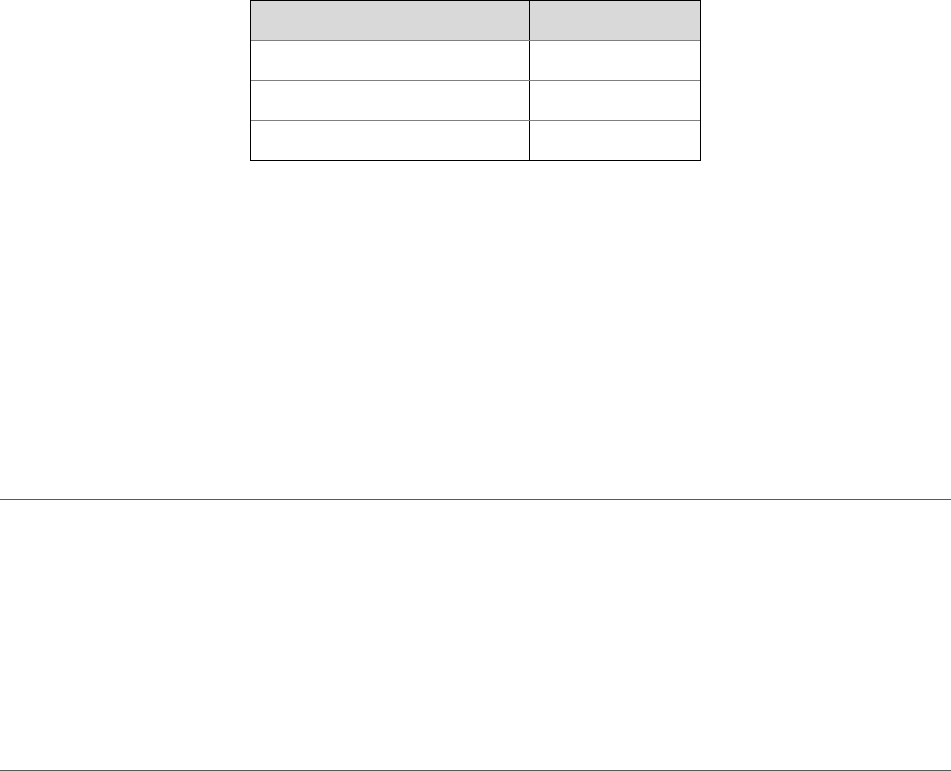
SAP Project
Program Charter
Page 7 of 20 04/14/2016
Delivery to Cost – this dimension considers the anticipated overall cost of delivery of the
program, taking account of the nature and timing of some of the program costs (for example,
fixed/variable costs, external/internally-allocated cost, etc.)
Delivery to Time – this dimension considers the importance of delivering the overall
implementation timetable on the scheduled dates, the timing of the key implementation
milestones, and any phasing of the implementation or deployment.
Delivery to Quality – this is a broad area that can include any or all of the degree of
achievement of planned benefits though changes in the process/systems requirements,
conformance of the delivered solution with the requirements or design, or uncorrected
defects in the delivered solution.
SAP Project Objective
Priority
Delivery to Cost
1
Delivery to Time
2
Delivery to Quality
3
Figure 2: MOA Program Priorities
In making decisions according to this prioritization of objectives, MOA will give consideration to:
How changes in one dimension affect other dimensions. For example, increasing
implementation time can provide for additional quality of the solution, but can lead to
increasing cost of delivery and increasing time to benefits achievement, which can affect the
MOA’s return on investment.
How changes in one of more of these dimensions affect the overall risk profile of the SAP
Project and MOA’s enterprise risk profile.
3 SAP PROJECT GOVERNANCE
The MOA is primarily responsible for the execution of the SAP Project. The MOA may use external
vendors to assist them in delivery of the program, and these vendors are accountable for performance
of the scope of the respective statements of work.
The MOA will follow formal and structured program management and governance processes to assist
them to in controlling the delivery of the program, managing their relationship with their service
providers, and realizing the planned business and IT benefits of the program.
4 SAP PROJECT GOVERNANCE ROLES
The overall structure of the SAP Project and its related governance bodies are described in the chart
below.
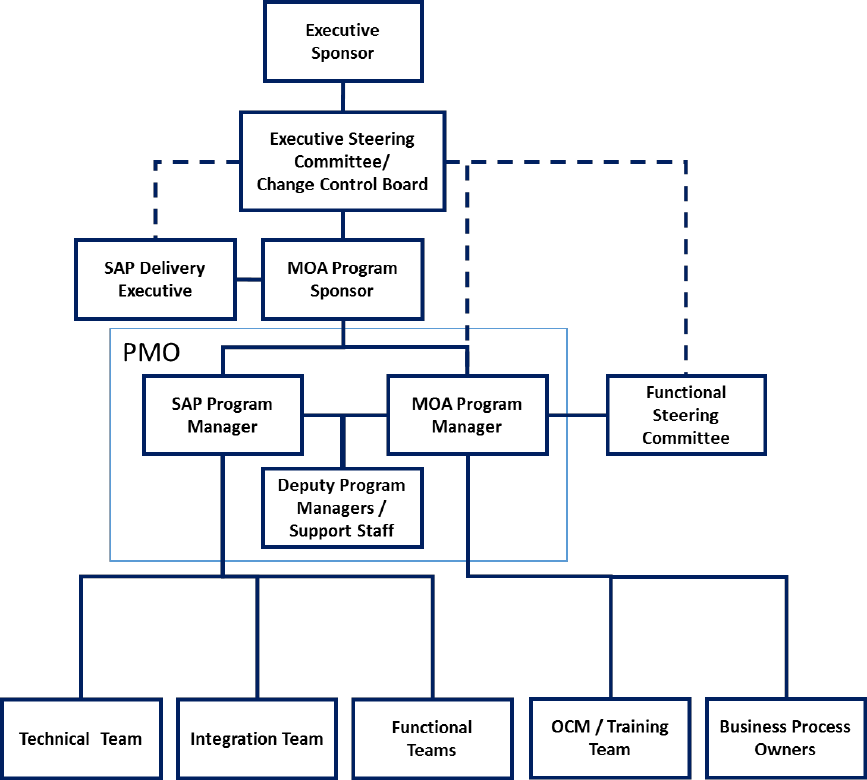
SAP Project
Program Charter
Page 8 of 20 04/14/2016
Figure 3: SAP Project Governance and Program Structure
4.1 EXECUTIVE SPONSOR
The SAP Project Executive Sponsor ensures the overall success of the SAP Project and the achievement
of MOA benefits. The Mayor is the Executive Sponsor of the SAP Project.
The key responsibilities of the Executive Sponsor are:
Creating and communicating the vision of the program, the Executive Sponsor is the “Change
Champion” for the SAP Project.
Providing clear direction and leadership throughout its duration.
Securing the investment required to set up and run the program, and to fund the transition
activities so that the desired benefits are realized.
Ensuring that the program delivers the desired capabilities, achieves its strategic outcomes
and realizes its benefits.
SAP Project
Program Charter
Page 9 of 20 04/14/2016
Establishing the program’s governance arrangements and ensuring appropriate assurance
mechanisms are in place.
Ensuring the viability of the business case.
Maintaining an interface with key stakeholders, keeping them engaged and informed.
Monitoring the key strategic risks facing the SAP Project.
Maintaining alignment of the program with the MOA’s strategic direction.
Commissioning independent assurance and audit reviews.
Ensuring the effectiveness and performance of the SAP Project organization.
Appointing the members of and setting priorities for the Executive Steering Committee.
Calling and chairing Executive Steering Committee meetings.
Calling and chairing the Integrated Change Control meetings.
Acting as the final arbiter in case of impasse at the Executive Steering Committee and Change
Control meetings, concerning meeting agenda items, High Impact and/or Critical change
requests.
4.2 EXECUTIVE STEERING COMMITTEE
The Executive Steering Committee is responsible for coordinating the resources within their span of
administrative control to support the objectives of the SAP Project. The Executive Steering Committee
ensures that the program is meeting its goals though high-level level monitoring of the conduct of the
program, and provides feedback and guidance to the Program Sponsor and Program Management as
required.
The key responsibilities of the Executive Steering Committee are:
Providing and ensuring the continuing MOA organizational context for the program.
Responsible for the development and implementation of the program’s governance
framework, including authorizing the program’s overall and subsidiary charters, and defining
the objectives and scope of the program.
Participating in milestone reviews and approving progression to the next phase of the
program.
Resolving strategic and operational issues affecting the program that need the input of senior
stakeholders to ensure the continued progress of the program.
Leading by example to implement the values implied by the transformational change.
Providing commitment and endorsement in support of the program at executive and
communications events.
Reviewing and approving High Impact and Critical change requests, and providing assistance
or advice to the Program Sponsor and Program Management as requested for other changes.
Authorizing closure of the program.
4.3 CHANGE CONTROL BOARD
The Executive Steering Committee will function as the Change Control Board, and be responsible for
the Integrated Change Control Plan. This function is a key element of the SAP Project’s Integrated
SAP Project
Program Charter
Page 10 of 20 04/14/2016
Change Control process, which provides a formal structure for requesting, approving and
implementing all changes to the SAP Project.
The Change Control Board is responsible for:
Reviewing and approving all Medium and High Impact change requests.
Engaging the Functional Steering Committee as deemed necessary for input on change
requests.
The Integrated Change Control Plan provides further details of the operation of the Change Control
process, and the composition and operation of the Executive Steering Committee.
4.4 PROGRAM SPONSOR
The Program Sponsor is accountable for leadership of the SAP Project from establishing the program,
through delivery of the new SAP solution and related MOA capabilities and realization of benefits, to
closure of the program.
The Program Sponsor participates as an Ex-Officio member of the Executive Steering Committee and
reports to the Executive Steering Committee, the Executive Sponsor and the Assembly. The key
responsibilities of the Program Sponsor are:
Supervision and control of the SAP Project as the MOA senior project leader.
Chief Liaison to the Executive Sponsor, and the Executive Steering Committee for the
coordination of the successful delivery of the program.
Planning and designing the program and proactively monitoring its overall progress, resolving
issues and initiating corrective action as appropriate.
Developing and implementing the program’s governance framework.
Managing and resolving any risks and other issues that may arise.
Maintaining the overall integrity and coherence of the program, and developing and
maintaining the program environment to support each individual component within it.
Managing the program’s budget, monitoring the expenditures and costs against budget as
the program progresses.
Facilitating the appointment of individuals and service providers to the program’s delivery
team.
Ensuring that the delivery of outputs or services from the program meets business
requirements, is to the appropriate quality, and is on time and within budget.
Managing the performance of the program team.
Maximizing the efficient allocation of resources and skills within the program.
Managing internal and external suppliers to the program.
Accepting program deliverables, including accepting contractual deliverables prepared by
external service providers.
Maintaining the focus of the program on realizing beneficial change.
Leading the development of the benefits management strategy.
SAP Project
Program Charter
Page 11 of 20 04/14/2016
Ensuring the development of, and business responsibility for, the benefits register and
benefits realization plan.
Identifying, defining and tracking the benefits and outcomes required of the program.
Managing communications with stakeholders.
Preparing the MOA organization for business change.
Initiating additional activities and other management interventions whenever gaps in the
program are identified or issues arise.
Reporting progress of the program at regular intervals to the Executive Sponsor and Executive
Steering Committee.
Reviewing and approving Low Impact changes, escalating other change requests to the
Executive Steering Committee as appropriate, and acting as a Ex-Officio member of the
Executive Steering Committee.
4.5 MOA PROGRAM MANAGER
The MOA Program Manager is accountable for functional delivery of the SAP Project by embedding
the SAP Project solution into the MOA’s business and IT operations, and facilitating business changes
required to implement and exploit the solution. The MOA Program Manager is a Ex-Officio of the
Executive Steering Committee.
The responsibilities of the MOA Program Manager are:
Day-to-day management of the SAP Project from institution to closure of the program with
the coordination of the Program Sponsor and the direct interaction with the SAP Program
Manager.
Oversight on behalf of the MOA of the SAP Scope of Work Agreement for the implementation
of the SAP.
Monitoring the program schedule and tracking progress against the schedule.
Monitoring and Controlling scope change.
Monitoring program risks and issue.
Communicating with project team members in coordination with the SAP Program Manager.
Ensuring the quality of the program deliverables and work products
Being the day-to-day advisory agent of the Executive Sponsor, Executive Steering Committee
and Program Sponsor ensuring successful delivery of the program and coordinating the
success of the project with the Program Sponsor.
Reporting progress of the project with the SAP Program Manager at regular intervals to the
Executive Sponsor and Executive Steering Committee.
Advising in the planning and designing the program and proactively monitoring its overall
progress, resolving issues and initiating corrective action as appropriate.
Advising in the development and implementation of the program’s governance framework.
Reporting progress of the program at regular intervals to the Executive Sponsor and Executive
Steering Committee.
Managing and resolving any risks and other issues that may arise with the implementation of
the system.
SAP Project
Program Charter
Page 12 of 20 04/14/2016
Ensuring that the delivery of outputs or services from the program meets business
requirements, is to the appropriate quality, and is on time and within budget.
Contributing to the development of the benefits management strategy.
Supporting the development of, and business responsibility for, the benefits register and
benefits realization plan are clearly attributed.
Identifying, defining and tracking the benefits and outcomes required of the program.
Facilitating the approval of the design of the “future operating model” for the MOA and
ensuring that it aligns with business requirements.
Identifying organization changes that occur outside the boundary of the program, which may
affect the business transition, solution adoption or benefits achievement.
Acting as a member of the Executive Steering Committee process.
Preparing the MOA organization for business change.
Ensuring effective communications with all areas of the Municipality and external
stakeholders.
Identifying and monitoring the performance metrics used to track the “operational health” of
the Municipality’s business and IT operations.
Implementing the mechanisms by which benefits can be realized and measured.
Advising the Program Sponsor whether the work of the program covers the necessary aspects
required to deliver the outputs and outcomes that will meet MOA business needs and lead to
benefits.
Preparing the affected business areas for the transition to new ways of working or
implementation of new business processes.
Ensuring that business stability is maintained during the transition and that changes are
effectively embedded in the business.
Initiating business assurance reviews to ensure that processes and capabilities are being
embedded and established.
4.6 PROGRAM MANAGEMENT OFFICE
The Project Management Office (PMO) comprises the SAP and MOA Program Managers and Deputy
Program Managers who oversee the work of the functional, technical and other teams that deliver
the work of the program. The PMO also includes a number of a number of support and administrative
staff who provide support to the operation of the PMO and the program team.
The SAP Program Manager manages the overall coordination and delivery of the program against a
baseline schedule, budget, and scope. The SAP Program Manager creates the program’s work
breakdown structure and defines the program’s work products and deliverables, and is responsible
for monitoring the program teams’ execution of the program activities and tasks contained within the
supporting program schedule.
The SAP Program Manager is also responsible for the development, implementation, maintenance
and execution of a broad set of operational program management plans and supporting processes
and procedures. These include processes for:
Maintaining the program schedule and tracking progress against the schedule.

SAP Project
Program Charter
Page 13 of 20 04/14/2016
Controlling scope change.
Managing program risks and issue.
Controlling the costs of the program for which the Program Managers are responsible.
Communicating with program team members.
Controlling document production, approval, storage and publishing.
Ensuring the quality of the program deliverables and work products.
The SAP Program Manager reports to the Program Sponsor and interacts on a regular basis with the
Program Sponsor, MOA Program Manager and program team leads.
The Program Management Office Charter provides further details of the composition and operation
of the Program Management Office.
5 PERFORMING ENTITIES
The following groups perform the day-to-day work of the SAP Project:
5.1 FUNCTIONAL TEAMS
The Functional Teams are responsible for the design of new/revised business processes and the
design, configuration, functional testing and deployment into Production of the SAP system in support
of these processes. Process design includes the documenting of business process requirements,
analysis and decomposition of the business process activities and tasks, and documentation of the to-
be process. Functional team members also assist in analyzing the business impact of the new
processes/system and provide business process input to the end-user training team. The Functional
Teams provide the functional design and testing of reports, forms, workflows, enhancements,
interfaces and data conversions.
The Functional Teams are each lead by a senior project manager (and/or project manager) from an
external service provider and a team lead from MOA. Each team comprises staff knowledgeable in
MOA’s existing and future business operations and processes, and in SAP functionality and SAP
implementation. Functional teams possess expertise in their assigned area, and are empowered to
make decisions on behalf of MOA concerning functional, process and operational changes that will
affect the future functional solution, following consultation with business stakeholders.
Key responsibilities of the functional teams include:
Developing and documenting the business process and SAP system design.
Facilitating workshops and presentations to validate business processes and solutions with
business stakeholders.
Configuring the SAP system and validating the functionality with business stakeholders.
Identifying business process scenarios, transactions and data to be used during testing
activities and developing test scripts.
Performing functional unit and integration testing of the process and SAP solution,
documenting the results obtained, identifying and resolving defects, and retesting to
confirm resolution.
SAP Project
Program Charter
Page 14 of 20 04/14/2016
Participating in and leading User Acceptance Testing.
Providing Production go-live and immediate post go-live support.
Support the Program Management Office in the execution of program management processes
by escalating risks and issues affecting their process area, creating and logging scope change
requests, and providing status reporting concerning planned and unplanned work of the team.
5.2 TECHNICAL AND INTEGRATION TEAMS
The technical and integration teams are responsible for the completion of all technical program
deliverables. These teams coordinate and manage changes to the overall technical architecture of the
MOA resulting from the implementation of SAP, including implementation of SAP infrastructure
(including operating system and database applications), integration or interfacing of SAP to other
MOA applications, network changes, and implementation of access controls via authentication and
authorization. The technical teams also design, develop, test and execute data conversion programs
to extract, map and load into SAP data from legacy MOA systems, and custom reports and workflows
to provide functionality required by MOA not available in the delivered SAP solution.
The technical teams are each lead by a senior project manager or project manager, and comprise MOA
and external service provider SAP and legacy application developers, security administrators, network
specialists, and database and operating system administrators. The technical teams are
knowledgeable about MOA’s existing and future enterprise architecture/business system landscape
and IT operations and processes, and in SAP functionality and SAP implementation.
Key responsibilities of the technical teams include:
Installing, configuring, monitoring, tuning, troubleshooting the SAP technical environment on
an ongoing basis, and making changes to MOA’s existing environment to allow integration
with SAP.
Implementing and maintaining standards and procedures for SAP and other system user
administration.
Specifying, developing and testing of reports, interfaces/integration, enhancements, forms
and workflows.
Specifying, developing and testing of data conversion programs and extraction,
transformation and loading of legacy system data into SAP.
Developing and executing an SAP technical cutover plan.
Developing ongoing IT service management processes.
Supporting the work of the program team by providing and configuring SAP and other
software tools to assist the team in collaborating with other team members and business
stakeholders, managing program documentation, and controlling and documenting the
results of testing activities.
Supporting the Program Management Office in the execution of program management
processes by escalating risks and issues affecting their technical area, creating and logging
scope change requests, and providing status reporting concerning planned and unplanned
work of the team.

SAP Project
Program Charter
Page 15 of 20 04/14/2016
5.3 ORGANIZATIONAL CHANGE MANAGEMENT AND TRAINING TEAMS
The Organizational Change Management and Training teams support the Change Champion in leading
the orderly transition of the Municipality from current business and IT operations to the desired future
operating model, and the achievement of sustainable business benefits by the Municipality.
Key responsibilities of the Organizational Change Management and Training teams include:
Change program management, including assessing change opportunities and risk, developing
an integrated change management strategy and plan, planning and managing the knowledge
and skills of the SAP Project team, and planning and developing SAP Project team
communications.
Benefits realization, including defining target benefits and related ownership, developing
plans to realize benefits, and tracking progress towards benefits achievement.
Business transition management, including analyzing the business impact of the SAP Project
process and IT changes, defining required changes in organizational structure, role design or
performance metrics, and creating plans to manage through the transition to steady-state
business and IT operations.
Organizational alignment, including identifying business stakeholders, assessing and business
readiness and change risks, and developing strategies and plans to lead and sponsor the
business change though stakeholder engagement.
Business communications, including developing a business stakeholder communication
strategy and plan, creating communication materials, delivering communication events, and
soliciting business stakeholder feedback and comments.
End-user training, including identifying end-user training needs, developing a training strategy
and plans, developing training materials and supplementary learning and support materials,
and delivering pre- and post-go live end-user training.
Post go-live sustainment, including planning to ensure adoption of the Synergy solution, and
designing, implementing and operating a post go-live support and sustainment organization
and processes.
Supporting the Program Management Office in the execution of program management
processes by escalating risks and issues affecting change management and training, creating
and logging scope change requests, and providing status reporting concerning planned and
unplanned work of the team.
6 ADVISORY BODIES
In addition to the roles and bodies that are involved in the governance and management of the SAP
Project, other bodies and groups that provide substantial advisory assistance to the program, include
the following:
6.1 FUNCTIONAL STEERING COMMITTEE
The Functional Steering Committee comprises senior representatives of MOA operating units and
business functions representing the target stakeholder and user groups for the program. As such, the
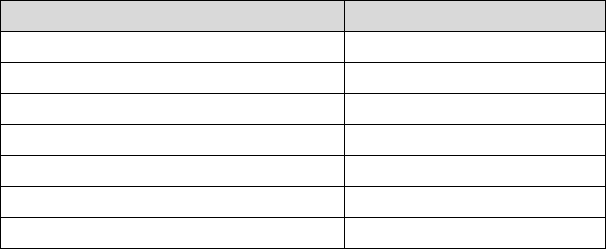
SAP Project
Program Charter
Page 16 of 20 04/14/2016
collective membership of the Functional Steering represents the continuing interests of the internal
and external stakeholder groups most affected by the program and possesses a deep expertise in and
understanding of current MOA business and IT operations, and is mandated to assist the SAP Project
team in defining the process and organizational changes associated with the program.
Key responsibilities of the Functional Steering Committee include:
Ensuring the design for the future operating model will result in effective, efficient and
sustainable operations, including business and IT operational processes, internal service
provider relationships and charging mechanisms, and the supporting resource model.
Soliciting input from business and IT subject matter experts, including business process
owners, to support decision-making and issue resolution related to the design of, and
transition to, the future operating model.
Ensuring the adequacy of internal controls, including auditability, over future MOA business
processes and during the transition.
Ensuring that the business transition plans provide for the continuity of business and IT
operations through the go-live and transition period.
Obtaining MOA resources to support SAP Project activities and sustainment.
Providing local business functional and operating unit sponsorship for the changes related
with the SAP Project.
Assisting with local stakeholder identification and engagement, assessment of the impact of
business changes, and assessment of business readiness for transition to the future operating
model.
Facilitating end-user attendance at training.
Assessing alternative options for, and the impact of, program change requests.
The members of the Functional Steering Committee will provide support to the functional, change
management and training teams on an individual or small group basis, including members as
appropriate for the subject matter. Informal working groups may be assembled to deal with cross-
functional decisions or matters of broad business impact. The Functional Steering Committee will also
meet bi-weekly in a general meeting, chaired by the Program Sponsor, in which members will present
updates on past and planned business change-related activity, consider current issues affecting the
scope of Functional Steering Committee efforts, and receive relevant communications from the
program team.
The members of the Functional Steering Committee include:
Department
Current Name
AWWU CFO
Glenda Gibson
Employee Relations
Karen Norsworthy
Controller
Tom Fink
AWWU CIO
Troy Swanson
ML&P Finance
Mollie Morrison
Purchasing
Ron Hadden
Treasury
Dan Moore
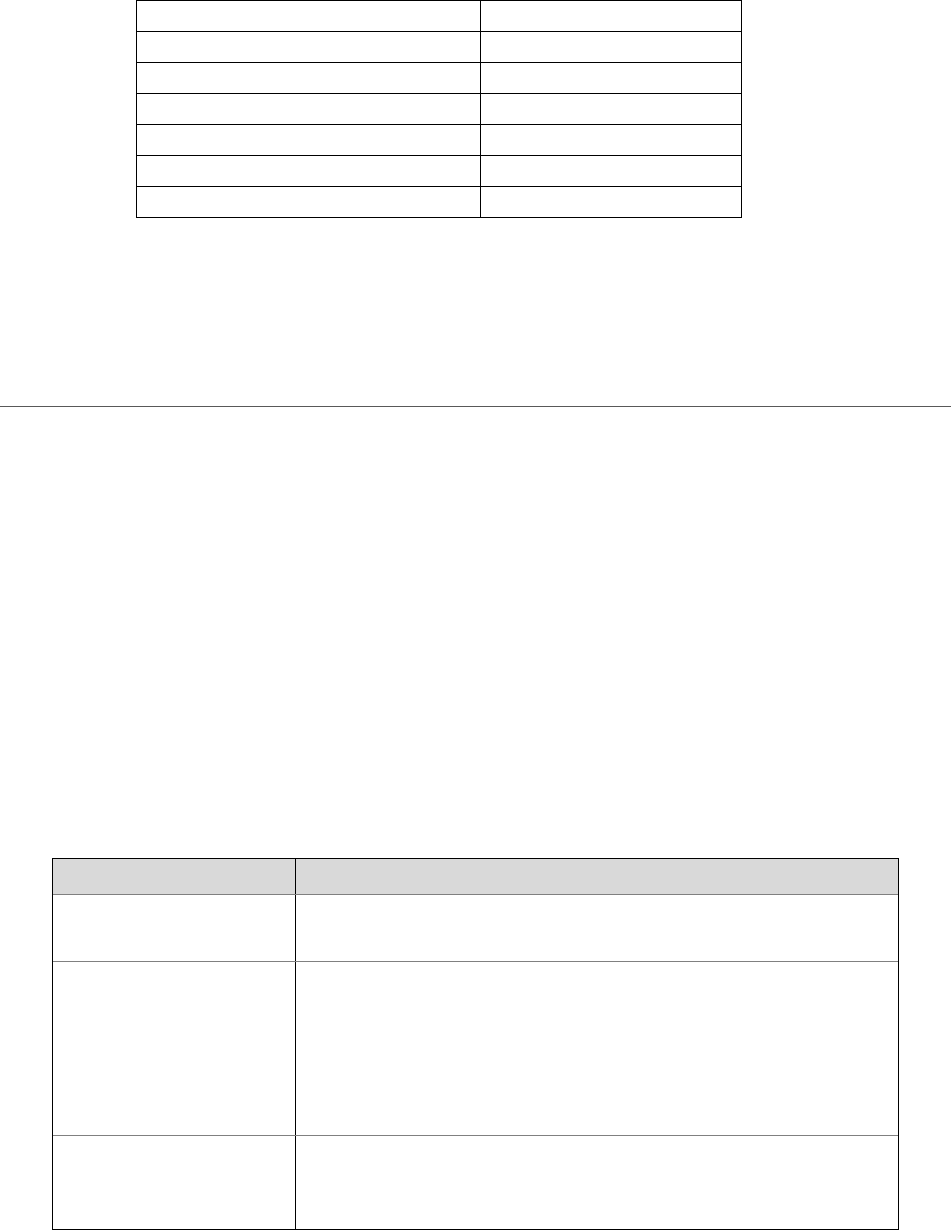
SAP Project
Program Charter
Page 17 of 20 04/14/2016
OMB Deputy Director
Marlyn Banzhaf
Superintendent Public Works
Maury Richardson
Director Payroll
Cindy Becker
Benefits
Juna Penney
Labor Relations
Jilanne Inglis
Director of IT
Zal Parakh
Sponsor & Chairman
Alden Thern
As the SAP Project lifecycle progresses, It is expected that the focus of the Functional Steering
Committee’s work and meetings will move from design of the future operating model, to change
sponsorship and communications, to deployment activities and post go-live operations.
7 AUTHORITY AND CONTROL
The following section describes the process, roles and responsibilities for program funding, decision-
making and issue resolution, and change request approval.
7.1 PROGRAM APPROVAL AND FUNDING
The Program Sponsor creates requests for additional funding. The Executive Steering Committee must
review all funding requests, following which Executive Sponsor presents them to the Assembly for
appropriation.
7.2 PROGRAM DECISION-MAKING AND PROGRAM CHANGES
Ultimate decision making and change approval authority for the SAP Project rests with the Executive
Sponsor and the Executive Steering Committee. In order to allow for efficient, effective and timely
decision-making, authority for decision-making and change approval is delegated to the program roles
and bodies as detailed below:
Governance Role/Body
Level of Authority
Executive Sponsor
Final arbiter of change in case of impasse at the Executive Steering
Committee concerning a High Impact and/or Critical change.
Executive Steering
Committee
Approval of all High & Medium Impact and Critical change
requests as detailed in the Change Control Plan. The Executive
Steering Committee will review and support (or reject) the
escalation of High Impact and Critical change requests including
the recommended course of action. Executive Steering
Committee
Program Sponsor
Approval of all Low Impact change requests. The Program Sponsor
will escalate all other change requests to the Executive Steering
Committee as appropriate.

SAP Project
Program Charter
Page 18 of 20 04/14/2016
Governance Role/Body
Level of Authority
MOA Program Manager
Conducts all day-to-day operations including decisions regarding
the OCM / training, BPO teams and MOA staff activities, schedule,
and resourcing, subject to no change in program scope, budget or
go-live or intermediate milestone dates.
SAP Program Manager
Conducts all day-to-day operations including decisions regarding
the technical, integration and functional project teams’ activities,
schedule, and resourcing, subject to no change in program scope,
budget or go-live or intermediate milestone dates.
Figure 4: SAP Project Decision-Making Authority
The change request process, including definitions and approval limits, is described in detail in the program’s
Integrated Change Control Plan. The Program Manager is responsible for defining the program’s change
control process and supporting tools/templates, maintaining the change request register, and ensuring the
completeness of change requests, including impact assessment and impact categorization. The
categorization of change requests is:
Change Category
Description
Low
No impact on program go-live date, program cost, anticipated benefits
or business readiness. Examples include changes to work breakdown
structure, changes to program management processes, updates to
previously-accepted program deliverables not affecting scope,
changes to program milestone dates not affecting the overall program
go-live date, etc.
Medium
Less than one month impact on program go-live date and <5% affect
program budget, or moderate change in anticipated benefits or
business readiness.
High
More than one month impact on program go-live date or >5% affect
program budget, or significant change in anticipated benefits or
business readiness.
Critical
High Impact Change Request with a required decision date less than 10
business days from the date on which the request is registered to avoid
affecting the program’s critical path.
Figure 5: SAP Project Change Request Categorization
8 CONTRACT MANAGEMENT AND ADMINISTRATION
The Program Sponsor initiates all contracts and subsequent contract amendments, whether for
external service providers or intra-municipality agreements. The Program Sponsor administers the
contracts, including deliverable acceptance, payment authorization and dispute management. The
Program Sponsor establishes the processes used to track the development of contractual deliverables
and the related deliverable evaluation criteria.

SAP Project
Program Charter
Page 19 of 20 04/14/2016
9 PROGRAM RESOURCE MANAGEMENT
The SAP Project Management Office will develop a program resource plan based on resource
requirements to complete program activities. The Program Sponsor is responsible for ensuring there
are sufficient skilled MOA resources assigned to the program to allow it to proceed on schedule, and
to develop the knowledge and skills that the MOA will need to sustain the Synergy solution after go-
live. The Program Sponsor will work with members of the Functional Steering Committee to identify
resources and backfill to meet requirements, and propose budget amendments to the Executive
Steering Committee and Executive Sponsor if required.
10 PROGRAM BUDGET
The Program Sponsor is responsible for administering the program budget. The program budget will
include:
The cost of all externally procured goods and services, whether on a fixed-fee or time-and-
materials basis.
The internally agreed cost of MOA staff resources assigned to the program and MOA services
consumed by the program.
Internal cost allocations as required by MOA program cost control guidance.
Contingencies and reserves.
The Program Sponsor will report the performance of the program against the approved budget to the
Executive Steering Committee on a regular basis, including the reason and mitigating actions for any
overall budget variance or use of contingency.
Any change in the project budget resulting from a program change request is approved by the
Executive Steering Committee as part of their approval of the related change request. The Program
Sponsor will report the total budget impact of approved change requests to the Executive Steering
Committee on a monthly basis.
11 CHARTER AND GOVERNANCE MAINTENANCE
The Program Sponsor is the Document Owner for the SAP Project Charter. Once approved, this version
will be made available to all program staff via the program’s document library as defined in the
Program Document Control Plan. Updates and revisions to this document may only be made pursuant
to the process defined in the Program Document Control Plan. This version remains in force until
superseded by a later approved version.

SAP Project
Program Charter
Page 20 of 20 04/14/2016
12 CHARTER APPROVAL
The Program Sponsor approves the Charter.
_____________________________________ _________________
Alden Thern, Program Sponsor Date
The Executive Sponsor approves the Charter.
_____________________________________ _________________
Ethan Berkowitz, Executive Sponsor Date
